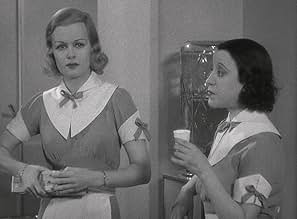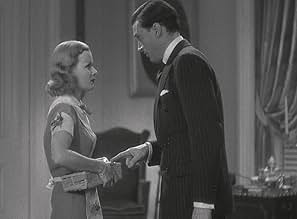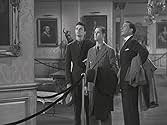CALIFICACIÓN DE IMDb
6.5/10
1.3 k
TU CALIFICACIÓN
Agrega una trama en tu idiomaSassy manicurist Eve Fallon is recruited as an even more brassy reporter and she helps police detective boyfriend Danny Barr break a jewel theft ring and solve the murder of a baby.Sassy manicurist Eve Fallon is recruited as an even more brassy reporter and she helps police detective boyfriend Danny Barr break a jewel theft ring and solve the murder of a baby.Sassy manicurist Eve Fallon is recruited as an even more brassy reporter and she helps police detective boyfriend Danny Barr break a jewel theft ring and solve the murder of a baby.
- Dirección
- Guionistas
- Elenco
- Premios
- 2 premios ganados en total
Henry Brandon
- Don Butler
- (as Henry Kleinbach)
Fred Anderson
- Elevator Operator
- (sin créditos)
William Arnold
- Customer
- (sin créditos)
Mary Bovard
- Manicurist
- (sin créditos)
Don Brodie
- Customer
- (sin créditos)
Ralph Brooks
- Man Exiting Elevator
- (sin créditos)
- Dirección
- Guionistas
- Todo el elenco y el equipo
- Producción, taquilla y más en IMDbPro
Opiniones destacadas
And in that of Raoul Walsh, as well. The early scenes, which try really hard to be cute, show no influence of Walsh. When it gets more into the career of policeman Grant, we see some fast-paced action and it makes sense as a Walsh project. Sort of.
Grant was young and hadn't become a major star yet. He looks great and does a creditable job. His female co-star is Joan Bennett. Now there was an interesting actress: She worked with all the great foreign directors when they came to Hollywood. She made several movies for Fritz Lang. She worked for Max Ophuls. She worked for Jean Renoir.
Here she is a blonde, like sister Constance. She's fine.
Walter Pidgeon looks young too. He is cast in the sort of role Robert Montgomery or Warren William got more frequently: He's a charming crook.
When the movie begins, Bennett is a manicurist. Then, suspiciously quickly, she's an ace newspaper reporter. Was this little film assembled from various attempts or is the plot just a little unconvincing? There are many wonderful reaction shots that move quickly from close-up of one bit player or extra to close-up of another. I think the most famous use of this sort of extreme close-up is that of the chatty woman in "Brief Encounter." But the ones here are great. Indeed, they elevate what is essentially a trivial movie up a notch or two.
Grant was young and hadn't become a major star yet. He looks great and does a creditable job. His female co-star is Joan Bennett. Now there was an interesting actress: She worked with all the great foreign directors when they came to Hollywood. She made several movies for Fritz Lang. She worked for Max Ophuls. She worked for Jean Renoir.
Here she is a blonde, like sister Constance. She's fine.
Walter Pidgeon looks young too. He is cast in the sort of role Robert Montgomery or Warren William got more frequently: He's a charming crook.
When the movie begins, Bennett is a manicurist. Then, suspiciously quickly, she's an ace newspaper reporter. Was this little film assembled from various attempts or is the plot just a little unconvincing? There are many wonderful reaction shots that move quickly from close-up of one bit player or extra to close-up of another. I think the most famous use of this sort of extreme close-up is that of the chatty woman in "Brief Encounter." But the ones here are great. Indeed, they elevate what is essentially a trivial movie up a notch or two.
Cary Grant and Joan Bennett co-star in Big Brown Eyes which had it been done over at Warner Brothers would have been standard material for James Cagney and Joan Blondell. In fact the whole project was an unusual one for Paramount, it was a gritty urban drama that Warner Brothers specialized in.
Grant is a police detective and Bennett a manicurist turned reporter (only in Hollywood) who team up in life and who team up to solve a series of robberies. What begins as high end jewel robberies turns deadly serious when during a payoff gone bad, a baby is killed in the park by a stray bullet.
When the doer Lloyd Nolan is acquitted in court due to perjured testimony and political influence, Grant quits the force and Bennett goes back to manicuring and look for justice in an unofficial manner. Need I say they get it though you have to see Big Brown Eyes to find out how its done. But I will say that forensics and Bennett's manicurist training does help a lot.
Walter Pidgeon is also in the cast as a crooked politician, hip deep in the rackets, a type that Thomas E. Dewey was putting in jail with increasing frequency in New York at the time. Two very funny supporting performances come from Marjorie Gateson as an amorous robbery victim with an eye for Cary Grant and Douglas Fowley who was one of the gang that they trick into squealing. That is the highlight of the movie.
Big Brown Eyes is a slick comedy directed by Raoul Walsh who gets the whole cast in sync like a Swiss watch. An unusual film for Cary Grant, but his fans will like it.
Grant is a police detective and Bennett a manicurist turned reporter (only in Hollywood) who team up in life and who team up to solve a series of robberies. What begins as high end jewel robberies turns deadly serious when during a payoff gone bad, a baby is killed in the park by a stray bullet.
When the doer Lloyd Nolan is acquitted in court due to perjured testimony and political influence, Grant quits the force and Bennett goes back to manicuring and look for justice in an unofficial manner. Need I say they get it though you have to see Big Brown Eyes to find out how its done. But I will say that forensics and Bennett's manicurist training does help a lot.
Walter Pidgeon is also in the cast as a crooked politician, hip deep in the rackets, a type that Thomas E. Dewey was putting in jail with increasing frequency in New York at the time. Two very funny supporting performances come from Marjorie Gateson as an amorous robbery victim with an eye for Cary Grant and Douglas Fowley who was one of the gang that they trick into squealing. That is the highlight of the movie.
Big Brown Eyes is a slick comedy directed by Raoul Walsh who gets the whole cast in sync like a Swiss watch. An unusual film for Cary Grant, but his fans will like it.
Big Brown Eyes would have been a big fat bomb if Cary Grant hadn't carried the movie. Even in such an early picture (1936) his debonair, yet cheeky gentleman style is evident. Playing a detective seemed odd, yet no matter what role he is cast in, he makes it his own. His romantic interest, Joan Bennett, seemed a tad too hard around the edges to play his girlfriend, but she did manage some decent repertoire with Grant, especially when the packing scene in Grant's apartment. Overall, the picture is uneven. It can't decide if it is a serious crime/drama or a light comedy. There is a scene where a stray bullet kills a baby (intimated) and there is nothing funny about that. Another scene a man is shot while arranging roses. It's incongruent action like these scenes that makes this movie just short of unwatchable. I have yet to see a Cary Grant movie that I didn't like, and this one seems a practice for his all out great flick His Gal Friday. Big Brown Eyes is watchable, only because of Cary Grant.
Yes, it's true. The actor who in a few years would become the ultimate symbol of film sophistication and elegance has the role of a policeman in this fairly routine comedy-drama. But no matter. Grant has enough charm and grace to make even this kind of part his own. How did he do it? Grant just stands out and is so likable while a lesser actor would just walk through this rather thankless assignment.
Joan Bennett played the kind of sassy brassy part that was often taken on by the likes of Ginger Rogers or Joan Blondell. Did anyone else catch her throwaway line that mirrored Mae West's famous "come up and see me sometime?" Many folks don't remember that Bennett was a blond BEFORE she became better known to later movie audiences as a brunette. Does anyone know of any other famous actress who made such a transition? Not me.
The rest of the cast did serviceable work in the film. Douglas Fowley, who played a humorous bit as one of the crooks, is far better known to most film audiences as the harried movie director in "Singing in the Rain," who had to deal with the chaotic and riotous problems of bringing sound to what were formerly silent movies.
But this film belongs to its male lead. You can almost see in watching the movies he made at this time just how he developed the layers of "business" that came together to produce the screen personality we all know as Cary Grant. He may have been paying his dues by taking on this fairly routine role. In the long run----we are all the better for it. Cary Grant was one of the greatest screen actors of all time----maybe the greatest.
Joan Bennett played the kind of sassy brassy part that was often taken on by the likes of Ginger Rogers or Joan Blondell. Did anyone else catch her throwaway line that mirrored Mae West's famous "come up and see me sometime?" Many folks don't remember that Bennett was a blond BEFORE she became better known to later movie audiences as a brunette. Does anyone know of any other famous actress who made such a transition? Not me.
The rest of the cast did serviceable work in the film. Douglas Fowley, who played a humorous bit as one of the crooks, is far better known to most film audiences as the harried movie director in "Singing in the Rain," who had to deal with the chaotic and riotous problems of bringing sound to what were formerly silent movies.
But this film belongs to its male lead. You can almost see in watching the movies he made at this time just how he developed the layers of "business" that came together to produce the screen personality we all know as Cary Grant. He may have been paying his dues by taking on this fairly routine role. In the long run----we are all the better for it. Cary Grant was one of the greatest screen actors of all time----maybe the greatest.
An adequate comedy/mystery, one that is serviceable while playing but will scarcely be remembered long after it concludes. In all fairness, the jumbled screenplay by Bert Hanlon and director Raoul Walsh has a reasonable degree of intriguing ideas spread throughout the picture's scant runtime, but the various story threads never gel into a completely coherent picture and the film is further hindered by some woefully leaden dialogue among it's lead characters. The film is still wholly watchable, and even enjoyable during certain stretches due to it's lead performers. The chemistry between Cary Grant and Joan Bennett (as a bickering couple thrown into a case involving stolen jewels and murder) is breezy and natural, and the duo significantly better the film with their thoroughly winning performances.
¿Sabías que…?
- TriviaAt 20 minutes, Eve Fallon (Joan Bennett) says to Danny Barr (Cary Grant), with a flirtatious wink, "if you happen to be around my way, come up and see me some time". This appears to refer to a famous, almost identical line said by Mae West to Cary Grant in "She Done Him Wrong" (1933), a playful in-joke that would have been obvious to contemporary audiences.
- Citas
Richard Morey: Cortig, if you bought a gift for a girl and she refused to accept it, what would you do?
Russ Cortig: [with a slow smile] I'd give it to my wife.
- ConexionesFeatured in The True Adventures of Raoul Walsh (2014)
Selecciones populares
Inicia sesión para calificar y agrega a la lista de videos para obtener recomendaciones personalizadas
- How long is Big Brown Eyes?Con tecnología de Alexa
Detalles
- Tiempo de ejecución
- 1h 17min(77 min)
- Color
- Relación de aspecto
- 1.37 : 1
Contribuir a esta página
Sugiere una edición o agrega el contenido que falta


































